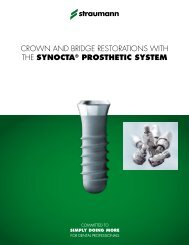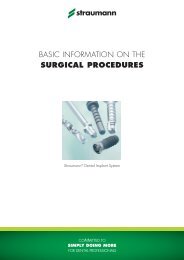Basic information on the SURGICAL PROCEDURE - Straumann
Basic information on the SURGICAL PROCEDURE - Straumann
Basic information on the SURGICAL PROCEDURE - Straumann
Create successful ePaper yourself
Turn your PDF publications into a flip-book with our unique Google optimized e-Paper software.
2. PrinciPLes of treatment PLanninG<br />
Indicati<strong>on</strong>s and c<strong>on</strong>traindicati<strong>on</strong>s for implant placement<br />
treatment planning is essential for <strong>the</strong> l<strong>on</strong>g-term success of oral rehabilitati<strong>on</strong> using<br />
dental implants. from <strong>the</strong> very beginning, indicati<strong>on</strong>s and c<strong>on</strong>traindicati<strong>on</strong>s<br />
must be carefully balanced for each patient, who is eligible for implant <strong>the</strong>rapy.<br />
indeed, proper patient selecti<strong>on</strong> is <strong>on</strong>e of <strong>the</strong> most important steps in treatment<br />
planning (Blanchaert 1998). <strong>the</strong>refore, <strong>the</strong> implant surge<strong>on</strong> must have a sound<br />
knowledge of <strong>the</strong> indicati<strong>on</strong>s and c<strong>on</strong>traindicati<strong>on</strong>s for implant placement.<br />
General and medical aspects (Table 3.1)<br />
Prior to any dental or surgical procedure, a medical history must be obtained from <strong>the</strong><br />
patient. <strong>the</strong> knowledge of former and current diseases, surgeries, and medicati<strong>on</strong>s<br />
helps to identify patients who are “at risk“. When <strong>the</strong>re are doubts, <strong>the</strong> physician or<br />
medical specialist treating <strong>the</strong> patient must be c<strong>on</strong>sulted for fur<strong>the</strong>r clarificati<strong>on</strong>.<br />
a general prerequisite for implant placement is that <strong>the</strong> patient must have an undisturbed<br />
wound healing capacity. in additi<strong>on</strong>, implants should not be inserted before jaw<br />
growth is complete (cr<strong>on</strong>in et al. 1994; thilander et al. 1994). however, implants<br />
might be installed before end of growth in special indicati<strong>on</strong>s, e.g. for orthod<strong>on</strong>tic<br />
reas<strong>on</strong>s (Bergendal et al. 1996; Wehrbein et al, 1996).<br />
in <strong>the</strong> following, general medical c<strong>on</strong>traindicati<strong>on</strong>s have been arranged in two<br />
groups: “risk factors“ and “high risk factors“.<br />
High risk factors<br />
p serious systemic diseases like rheumatoid arthritis or osseous disorders like<br />
osteomalacia or osteogenesis imperfecta are c<strong>on</strong>sidered high risk factors.<br />
however, osteoporosis does not c<strong>on</strong>traindicate <strong>the</strong> use of dental implants (Baxter &<br />
fattore 1993; Dao et al. 1993).<br />
p Patients who are immunocompromised due to viral infecti<strong>on</strong> (hiv) or medicati<strong>on</strong><br />
(cortico-steroids, <strong>on</strong>cologic chemo<strong>the</strong>rapy or o<strong>the</strong>r immunosuppressives) have<br />
a clearly reduced wound healing capacity and an inappropriately resp<strong>on</strong>ding<br />
immune system.<br />
p alcohol and drug abusers as weil as patients with psychological or mental<br />
disorders are not reliable with regard to compliance, home care and follow-up<br />
appointments (uncooperative patient) (hogenius et al. 1992).

















